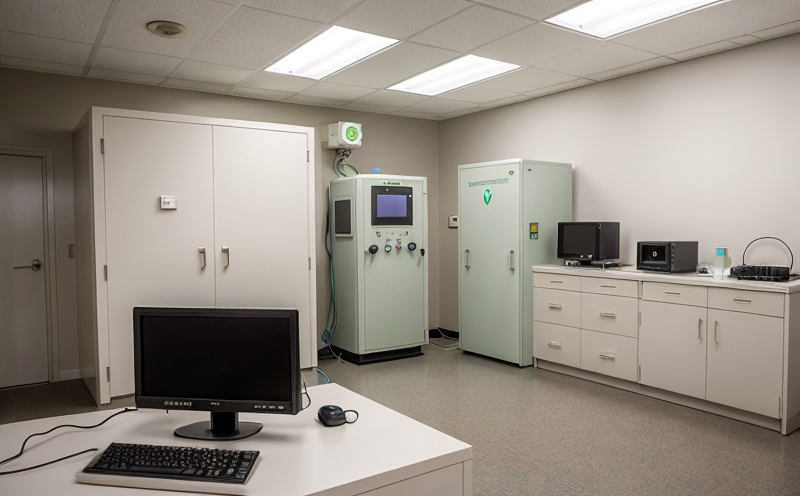ISO 15379 Radiological Protection – Workplace Dosimetry Testing
The ISO 15379 standard provides a framework for ensuring that workers in environments with ionizing radiation are protected against the potential health risks associated with exposure. This standard is particularly relevant for industries such as healthcare, nuclear power plants, and manufacturing facilities where personnel may be exposed to harmful levels of ionizing radiation. The primary objective of this testing protocol is to ensure compliance with regulatory requirements and to safeguard worker health.
Workplace dosimetry involves the measurement and monitoring of radiation exposure in occupational settings. This process typically includes the use of personal dosimeters, which are small devices worn by individuals working within these environments. These devices measure the cumulative dose received over a specified period or during a specific task. The data collected is then analyzed to determine whether it falls within safe operational limits.
The ISO 15379 standard mandates that organizations conducting this type of testing must adhere to strict guidelines regarding dosimeter selection, placement, and calibration. It also requires regular validation checks to ensure the accuracy of measurements. Compliance with these standards not only protects workers but also helps facilities avoid potential legal issues and fines.
Implementing ISO 15379 workplace dosimetry testing can lead to significant improvements in occupational health and safety practices. By adhering to this standard, organizations demonstrate their commitment to worker well-being and regulatory compliance. Moreover, consistent monitoring allows for early detection of any potential issues, enabling prompt corrective actions.
One key aspect of ISO 15379 testing is the use of personal dosimeters. These devices play a crucial role in accurately measuring radiation exposure levels. They are typically worn by workers in areas where ionizing radiation is present. The dosimeters can be either passive or active, depending on the specific requirements and constraints of the environment.
Another important element of ISO 15379 testing involves the calibration process. Calibration ensures that all dosimeters function accurately under various conditions. This step is critical because even minor inaccuracies could lead to incorrect assessments of radiation exposure levels, potentially exposing workers to unnecessary risks or leading to unwarranted evacuations.
The analysis phase following the collection of dosage data is equally important. Specialists review the collected information to assess compliance with established limits and identify any areas requiring improvement. This detailed examination allows for targeted interventions aimed at enhancing safety protocols and reducing exposure levels where necessary.
Compliance with ISO 15379 standards helps organizations maintain a robust occupational health and safety program. Regular monitoring ensures continuous improvement in protecting workers from the adverse effects of ionizing radiation. By adhering to these guidelines, companies can contribute positively towards maintaining a safe work environment while also safeguarding their reputation as responsible corporate citizens.
In conclusion, implementing ISO 15379 workplace dosimetry testing is essential for ensuring that employees in potentially hazardous environments receive adequate protection against ionizing radiation. Through rigorous monitoring and analysis, organizations can effectively manage risks associated with this form of exposure, thereby promoting both worker safety and regulatory compliance.
Why It Matters
The importance of ISO 15379 workplace dosimetry testing cannot be overstated. In industries where workers are exposed to ionizing radiation, such as healthcare facilities or nuclear power plants, proper protection against harmful levels is paramount. Failure to do so can result in serious health consequences for employees, including increased risk of cancer and other radiation-induced illnesses.
ISO 15379 provides a comprehensive approach to managing these risks by setting clear standards for dosimeter use, calibration procedures, and data analysis methods. Adherence to this standard ensures that organizations are taking proactive steps to protect their personnel from potential hazards.
A key benefit of implementing ISO 15379 is the enhanced protection it offers workers in high-risk environments. By regularly monitoring radiation exposure levels using compliant dosimeters, employers can identify and address any issues promptly, thereby minimizing the risk of overexposure.
- Ensures accurate measurement of radiation doses received by employees
- Facilitates early detection of potential health risks due to prolonged or excessive exposure
- Supports compliance with international regulatory requirements
- Promotes a culture of safety within the organization
In addition to these immediate benefits, ISO 15379 also contributes to long-term sustainability by fostering continuous improvement in workplace safety practices. Regular reviews and adjustments based on monitored data help maintain optimal protection standards even as working conditions evolve over time.
Why Choose This Test
Selecting the appropriate testing method is crucial when it comes to protecting workers from ionizing radiation. For ISO 15379 workplace dosimetry, there are several compelling reasons why this particular standard should be chosen:
- Regulatory Compliance: Adhering to ISO 15379 ensures that your organization meets all necessary legal and regulatory requirements related to occupational radiation protection.
- Achieving Safety Standards: By following the procedures outlined in this standard, you can significantly reduce the risk of exposure for workers operating in environments with ionizing radiation.
- Enhanced Reputation: Demonstrating a commitment to worker safety through rigorous adherence to established standards enhances your company's reputation as an ethical and responsible employer.
- Promoting Continuous Improvement: Regular reviews based on monitored data allow for continuous refinement of safety protocols, ensuring they remain effective in changing conditions.
In summary, choosing ISO 15379 workplace dosimetry testing not only meets regulatory expectations but also prioritizes the health and well-being of your workforce. This approach underscores a dedication to maintaining safe working environments while contributing positively to overall corporate responsibility.





